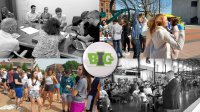Partnership Strategies for Real-World Projects
Students gain by taking on interdisciplinary projects with community nonprofits, businesses, and government agencies.
Giving students opportunities to tackle real-world problems is a surefire strategy to increase engagement. Yet many teachers struggle to design academically rigorous projects that connect students with the world beyond the classroom. How are they supposed to engage with community partners, recruit content experts, and enlist authentic audiences—all while attending to student learning goals?
Iowa BIG, a public high school in Cedar Rapids, Iowa, has taken the mystery out of real-world learning. The school’s competency-based model emphasizes passion, projects, and community rather than a packaged curriculum. Students learn across content areas by choosing to undertake interdisciplinary projects with community nonprofits, businesses, and government agencies.
In recent projects—all aligned to Iowa CORE state standards and Next Generation Science Standards—students have advised city officials on how to improve their use of social media, created a dance therapy curriculum to promote inclusion for people with special needs, investigated the use of drones for agriculture, and engineered a plan to redevelop an abandoned meatpacking property for recreational use.
To help grow this break-the-mold high school, which draws students and financial support from several districts in the region, XQ: The Super School Project has awarded Iowa BIG $1 million in grant support.
Engaging With Stakeholders
I had a chance to talk with the founders of Iowa BIG while researching All Together Now: How to Engage Your Stakeholders in Reimagining School.
Trace Pickering, Iowa BIG’s executive director and cofounder, and Troy Miller, the school’s director of strategic partner development, shared practical insights about building effective partnerships. Here are the highlights.
Bring partners into school change conversations. Iowa BIG came about through creative community outreach. Before even starting to design the new school in 2012, Pickering and Iowa teacher Shawn Cornally invited adults from the community to go back to school for a day and then discuss the experience. Some 50 citizens of diverse ages and backgrounds took part. Their unanimous conclusion: Traditional high school was leaving too many students bored while doing too little to prepare them with the skills needed for college, careers, and citizenship.
Those conversations informed the Iowa BIG model, which deliberately takes down content silos and removes barriers between school and community. Having stakeholders in on the conversations from the beginning has garnered broad support for bringing innovative ideas into public education.
Find the sweet spot for collaboration. “The new curriculum is community,” explains Miller. “Our community has enough problems and opportunities for students to have an endless number of things to do.”
Iowa BIG uses those authentic problems as context for addressing academic standards. “The teacher’s job is to build content and curriculum around the project, not the other way around,” explains Pickering. If students express interest in a project idea, teachers look for “connections to important, deep content.” Teachers have to be agile to help students learn unfamiliar content or improve their time-management skills. During a project, “they have to read the tea leaves,” Pickering says, and adjust instruction to help each student succeed.
To make sure everyone’s on the same page when it comes to project goals, Miller serves as a conduit between school and community. He translates as needed, drawing on his background in both education and business to clarify goals, roles, and expectations. He also helps partners find their sweet spot for working with students.
Some partners are comfortable working directly with students; others want teachers to play a more central role in facilitating student participation. Some partners need coaching about how to listen to students’ ideas and entrust them with real responsibility. Miller has identified a range of options for partners, from sharing space or equipment to having students fully integrated into their organization for the duration of a project.
Have partners pitch. Iowa BIG starts the year with a Partner Palooza where community organizations pitch project ideas to students. Students are also welcome to suggest project ideas, but to get a green light they have to show substantial learning opportunities and also appeal to a community partner.
When it launched in 2013, Iowa BIG had to work to convince partners to give students a chance. Pickering says an early breakthrough came about when he encouraged partners to look for right-sized opportunities for students: “I told them, ‘Don’t give us the projects that are mission critical. What else is on your wish list that you don’t have resources for right now?’” Even if students are not successful, Pickering told partners, “you will learn what didn’t work, and you won’t have to repeat that mistake. Meanwhile, you’ll be exposing kids to your industry and your issues. And if they do succeed—even better.”
Now the school gets more requests than it can accommodate. Iowa BIG projects frequently garner headlines and earn positive attention, for students and partners alike. “The more we’re in the community,” Miller says, “the more this model propagates itself.” To accommodate a surge of interest in its community-as-curriculum model, Iowa BIG designates three days annually for visitors.
Consider Your Community’s Readiness
Here are some questions to consider if your school is inspired by the Iowa BIG model:
- Within your school or community, who might have the skill and know-how to be the point person for building partnerships?
- What barriers could get in the way of connecting your students with local partners to tackle challenges together? How could you overcome them?
- How might you invite diverse stakeholders to join the conversation about school change?
- How will your school or system prepare teachers to be agile curriculum designers and facilitators of real-world learning?
